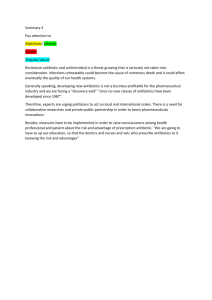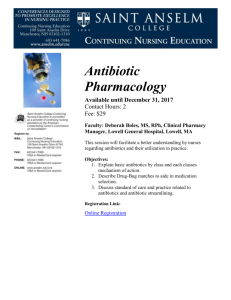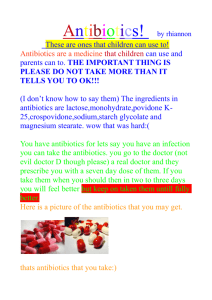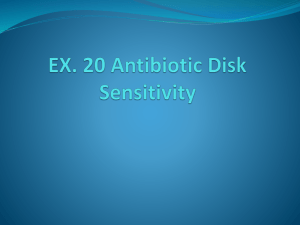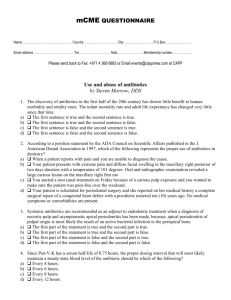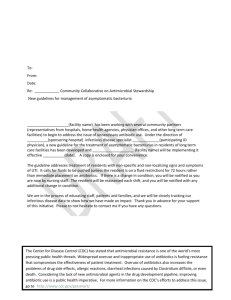Introduction to Antibiotics
advertisement
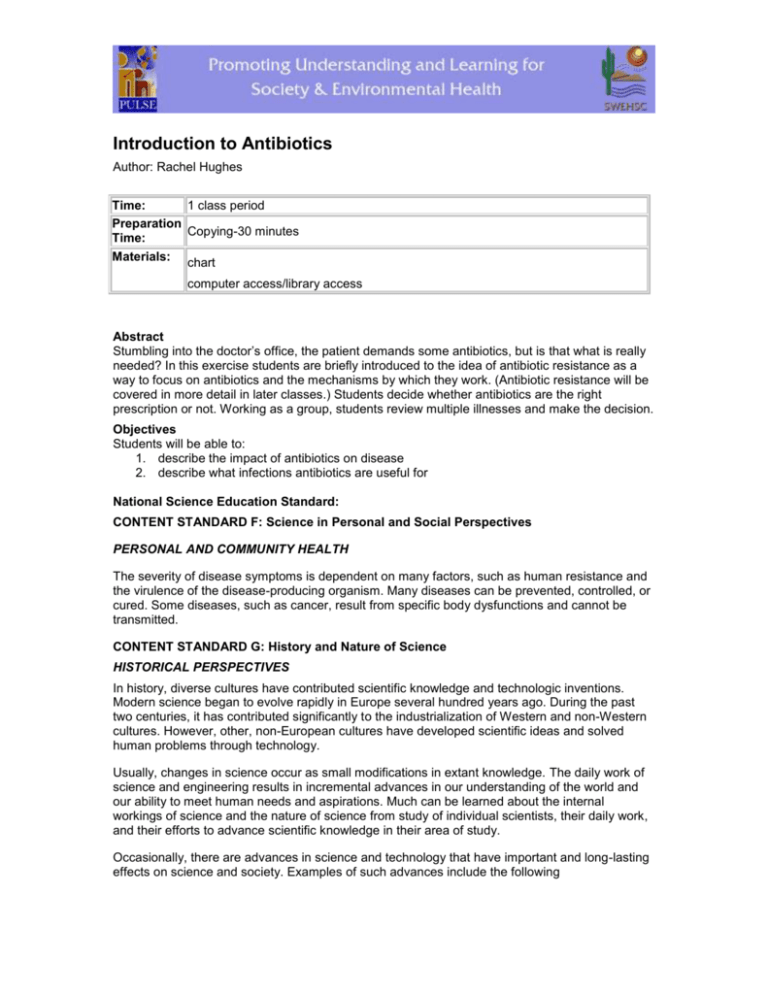
Introduction to Antibiotics Author: Rachel Hughes Time: 1 class period Preparation Copying-30 minutes Time: Materials: chart computer access/library access Abstract Stumbling into the doctor’s office, the patient demands some antibiotics, but is that what is really needed? In this exercise students are briefly introduced to the idea of antibiotic resistance as a way to focus on antibiotics and the mechanisms by which they work. (Antibiotic resistance will be covered in more detail in later classes.) Students decide whether antibiotics are the right prescription or not. Working as a group, students review multiple illnesses and make the decision. Objectives Students will be able to: 1. describe the impact of antibiotics on disease 2. describe what infections antibiotics are useful for National Science Education Standard: CONTENT STANDARD F: Science in Personal and Social Perspectives PERSONAL AND COMMUNITY HEALTH The severity of disease symptoms is dependent on many factors, such as human resistance and the virulence of the disease-producing organism. Many diseases can be prevented, controlled, or cured. Some diseases, such as cancer, result from specific body dysfunctions and cannot be transmitted. CONTENT STANDARD G: History and Nature of Science HISTORICAL PERSPECTIVES In history, diverse cultures have contributed scientific knowledge and technologic inventions. Modern science began to evolve rapidly in Europe several hundred years ago. During the past two centuries, it has contributed significantly to the industrialization of Western and non-Western cultures. However, other, non-European cultures have developed scientific ideas and solved human problems through technology. Usually, changes in science occur as small modifications in extant knowledge. The daily work of science and engineering results in incremental advances in our understanding of the world and our ability to meet human needs and aspirations. Much can be learned about the internal workings of science and the nature of science from study of individual scientists, their daily work, and their efforts to advance scientific knowledge in their area of study. Occasionally, there are advances in science and technology that have important and long-lasting effects on science and society. Examples of such advances include the following Teacher Background A seemingly incidental discovery had a revolutionary impact on medicine. Alexander Fleming discovered penicillin, a mold growing on some Petri dishes and also noted that where the penicillin grew, the bacteria did not. What Fleming found revolutionized medicine, as these antibiotics were able to target bacterial cells, leaving the host relatively unaffected. This significantly reduced the loss of life to infection during World War II. Antibiotics attack bacteria without harming cells belonging to the host organism. There are two ways that antibiotics do this. Antibiotics like penicillin are called Bactericidals and kill bacteria by inhibiting cell wall synthesis and thereby damaging the cell. Human and animal cells do not have cell walls, so these antibiotics do not damage them. Erythromycin and tetracycline are bacteriostatic antibiotics; they inhibit nuclei acid and protein synthesis. This type of antibiotic can affect the patient receiving them, but because they have a greater effect on bacterial cells than animal cells they can still be useful. Related and Resource Websites Center for Disease Control http://www.cdc.gov PBS Evolution website, complete with web activities, video clips etc. is very informative http://www.pbs.org/wgbh/evolution/ Activity 1. On the board have the following statement: “You stumble into the doctor’s office, sick as a dog. You have a fever and stomach ache, as well as a runny nose. Your doctor suggests that you take to your bed, drink lots of fluids, but doesn’t give you any medication. You’re so mad you could spit. Why hasn’t the doctor given you any antibiotics?” As students walk in they should respond to this statement in a written form. 2. Once you have given students enough time to respond to the statement ask them why the doctor doesn’t provide any antibiotics. [Antibiotics are not effective treatment for a virus infection.] 3. Ask students what antibiotics are used for. [Treating infections of bacteria] Do they know who ‘discovered’ the first antibiotic? [Alexander Fleming] 4. Lead the students in a discussion about the discovery of penicillin by Alexander Fleming and the impact that it had on disease. Explain that antibiotics act on bacteria by either inhibiting cell wall synthesis or inhibiting protein synthesis thereby damaging the cells. Ask students why this wouldn’t affect the host cells. [Human and animal cells do not have cell walls and so are not impacted by the antibiotic. Antibiotics affect bacteria protein synthesis at a much greater rate than human or animal protein synthesis.] 5. Review what type of pathogen is impacted by antibiotics. [bacteria] 6. Now present students with the table. In pairs or threes they should work on the table. They are to imagine that as a doctor they are actively trying to avoid the over prescription of antibiotics. The table lists multiple types of diseases, students should identify what the nature of the illness is, what kind of pathogen is being considered, if any, and if an antibiotic will work. Illness Strep throat Measles Chicken pox Ear ache Common cold Cause (Pathogen name and type if appropriate) Antibiotics –Yes/No AIDS Allergies “Mono” 7. Students should research each common illness and complete the table. 8. Once they have finished the table they are to suggest at least two other illnesses that might be a little tricky for their peers to work out. 9. Once students have completed the chart you may wish to direct them to the impressive PBS website on evolution: http://www.pbs.org/wgbh/evolution/survival/enemy/ or to the CDC pamphlets on Antibiotic resistance: http://www.cdc.gov/drugresistance/community/files/CDC_parents_brochure1.pdf 10. Students should review the talks or the pamphlet and summarize what the problem is and why it has occurred. Have patients played a role in the problem? Why and how? Embedded Assessment 1. The written statement at the beginning of class allows for a pre-assessment of students’ knowledge about antibiotic targets. 2. The chart allows students to explore a variety of common illnesses and identify whether they can be treated with antibiotics. Homework
